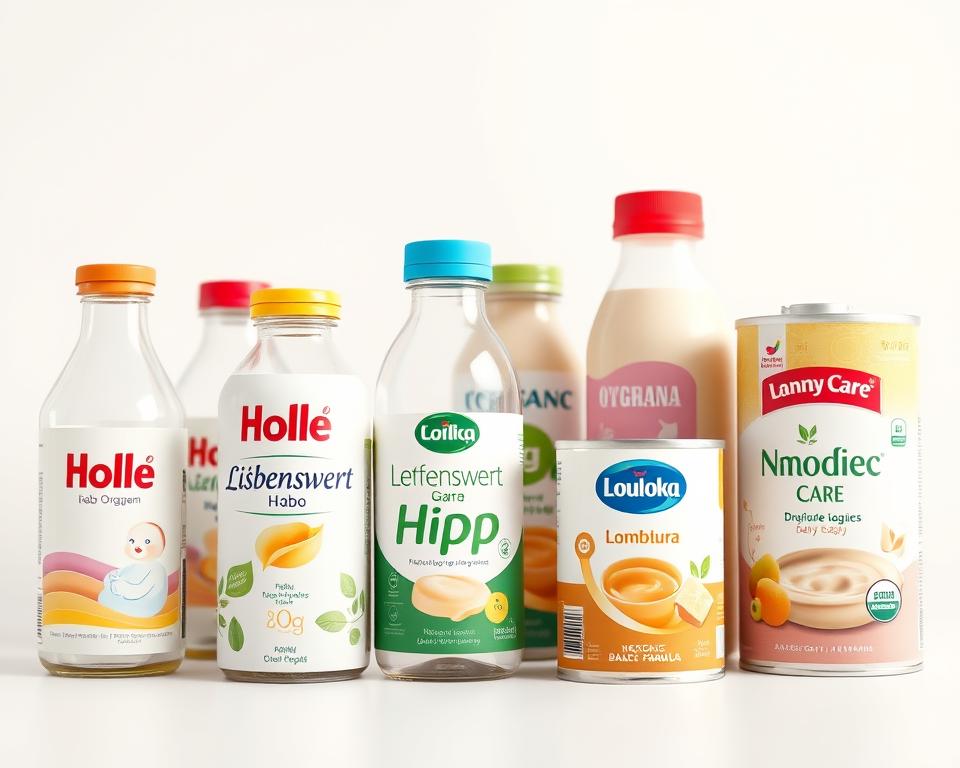Locate the Finest Organic Baby Formulas: A Parent’s Guide
Roughly 80% of U.S. parents turn to formula within baby’s first twelve months. This is often due to breastfeeding challenges. Selecting the proper organic formula shop proves crucial for such households. This resource supports parents in selecting top organic options for infant nutrition.
We’ll review key brands and blends with an eye on purity and nutrients. This information is vital for ensuring a healthy start for your child.
Choosing the right food for your baby is a critical decision for every parent. Formulas made from certified organic ingredients have surged in demand. It provides a healthier option for infants. Free from artificial pesticides and fertilizers, they offer infants a purer beginning.
Parents are increasingly mindful of the absence of harmful chemicals like GMOs and artificial additives. This awareness highlights the growing preference for organic formulas as a safe choice for infant health.
Benefits of Organic Ingredients
Organic ingredients in baby formulas offer significant benefits. They undergo strict testing for superior quality and protected safety. Picking organic varieties lets caregivers know their baby avoids toxic residues.
The cultivation processes involved in organic farming emphasize sustainability and environmental preservation. Thus, organic choices support both your baby’s health and the planet.
Related Developmental Gains
The health advantages of organic formula reflect a positive impact on infant development. Many studies suggest that babies receiving organic nutrition may exhibit fewer gastrointestinal issues and a lower likelihood of allergies. This can be attributed to the pure formulation free from synthetic additives.
Caregivers appreciate the peace of mind from these well-rounded formulas. Such formulas aid healthy growth and general well-being.

Key Features to Look for in Organic Baby Formula
Choosing the best organic baby formula is a critical decision for a baby’s health. Examine both protein origins and vital micronutrients. The type and ratio of proteins can affect how well a baby digests and uses nutrients. Awareness of critical vitamins and fats secures optimal development and health.
Protein Origin and Proportion
Whey and casein form the protein base in many formulas. Whey breaks down quickly and casein releases nutrients gradually. A whey-lean blend suits delicate infant digestion. Organic brands usually prioritize elevated whey levels for ease of digestion. Look for formulas that clearly list their protein sources and have a balanced ratio for healthy growth.
Essential Nutrients and Additives
Critical nutrients make a big difference in formula selection. DHA and ARA are critical for brain and eye health. Prebiotic content promotes balanced digestion and a robust immune response. Check for these additives in formulas to ensure your baby gets a full range of nutrients. These organics provide robust nutrient profiles.
| Protein Source | Benefits | Whey-to-Casein Ratio |
|---|---|---|
| Whey | Easier digestibility|Gentle on tummies|Quick absorption | Higher ratio is better|Lean whey blend preferred|Above 60% ideal |
| Casein | Slow release of nutrients|Sustained nourishment|Stomach-friendly over time | Lower ratio preferred in early months|Casein kept minimal|Around 40% or less |
Top-Rated Organic Formula Brands
Caregivers frequently choose reputable names for organic formula. Let’s explore some top choices, highlighting their unique features and standout qualities. They lead the organic formula market, serving diverse dietary demands.
Kendamil Whole Milk Formula
Kendamil’s formula uses pure whole milk for distinct creaminess. This formula boasts a rich, creamy texture and avoids controversial additives. Moms and dads choose it for its minimal processing and wholesome profile. You can easily purchase Kendamil with a few clicks.
HiPP Combiotik’s Soothing Formula
Engineered for delicate tummies, HiPP Combiotik minimizes distress. It includes prebiotics and probiotics for better digestion. Caregivers rely on HiPP’s quality for peace of mind at organic retailers.
Holle Bio: Trusted European Quality
Holle’s approach uses biodynamic methods for superior formula purity. It’s known for its rigorous quality control and commitment to health and the environment. Caregivers opt for Holle because of its genuine flavor and nutrient profile.
Aussie Bubs Grass-Fed Blend
Aussie Bubs is notable for using grass-fed cow ingredients, ensuring high nutritional value. All components reflect a back-to-nature approach. This distinct sourcing helps caregivers identify premium organics.
Bobbie’s Forward-Looking Formula
Bobbie is at the forefront of baby nutrition, blending modernity with thoughtful formulation. It meets contemporary dietary needs while upholding organic integrity. Moms and dads trust Bobbie for its evidence-based, organic formula.
Picking the perfect blend means matching formula to your infant’s health requirements. Understanding their dietary sensitivities is key to finding a formula that supports their health without discomfort. Ingredients are critical, as they can greatly affect babies with sensitive stomachs.
Evaluating Food Sensitivities
Many infants have dietary sensitivities, leading to reactions to certain formula components. Look for formulas designed for sensitive infants. Hypoallergenic formulas use partial hydrolysis and minimal lactose. They help alleviate discomfort and support healthy digestion.
Always consult a pediatrician to determine the most suitable formula for your baby’s specific needs.
Focusing on Tummy Comfort
Ease of digestion hinges on selecting a formula made for comfort. Inclusions of pre- and probiotics support a balanced gut flora. They help in developing a healthy gut flora, improving digestion and nutrient absorption.
Organic blends designed for breastfed infants deliver key components.
Steps to Switch to Organic Formula
You can transition infants from breastfeeding or standard formula to organic smoothly. Grasping best practices eases the process for you and baby. Slowly shifting ratios eases acceptance and prevents distress.
Transition Timeline
Begin with small amounts of organics mixed in. Follow these tactics for easy switching:
- Kick off by blending one part organic with three parts regular formula.
- Over the next week, gradually increase the proportion of organic formula while decreasing the traditional formula.
- Monitor your baby’s reactions closely. If your baby shows signs of discomfort, slow down the process.
- Serve the new formula during calm periods so baby links it with comfort.
- Keep consistent feeding times to support the changeover.
Indicators of Successful Switching
Spotting these indicators confirms a smooth adaptation:
- Infant feeds calmly with little to no protest.
- Normal poops and easy digestion continue.
- No significant changes in appetite or feeding patterns.
- Baby smiles and rests peacefully after meals.
Patience pays off—look for these signs for a favorable outcome.
Organic Baby Formula vs. Traditional Formula
Many parents are torn between organic baby formula and traditional formula when it comes to their infant’s nutrition. Your choice shapes your infant’s nourishment quality. Concern over pure components and wellness perks drives the decision.
Ingredient Differences
The main difference between organic and traditional formulas is in their ingredients. Organics rely on farm-fresh ingredients without synthetic extras. Labels such as HiPP and Kendamil source from eco-friendly dairies. Regular formulas can pack artificial additives and GMO-derived compounds. It explains why caregivers favor organics for a natural approach.
Price Considerations
Organic formulas generally carry premium pricing because of certification expenses. These formulas cost more because of strict organic compliance fees. Despite the higher cost, many parents see the health benefits as worth the investment. Evaluating price and quality ensures a match with financial and health priorities.
The rise of online organic formula shops has revolutionized how parents buy organic baby formula. Caregivers order premium blends with a few clicks. It enables discovery of specialty formulas for different needs.
Online Retail Advantages
E-commerce fits into jam-packed daily routines. Shop at home or on the go with no store trips required.
- Ease of access
- Variety: Explore an extensive selection of organic baby formulas across different brands
- Competitive Pricing: Take advantage of promotions and discounted prices often available through online retailers
Formula Subscription Benefits
Scheduled formula deliveries are on the rise. They make buying formula easier by setting up regular deliveries of your preferred formulas.
Key features of infant formula subscriptions include:
- Never worry about restocking
- Customizable Frequency: Choose how often to receive deliveries based on your family’s needs
- Subscription rates often beat retail prices
Regulations Governing Organic Infant Nutrition
Maintaining high standards for organic formulas involves strict oversight. It involves a detailed framework of regulatory standards. FDA mandates safeguard formula nutrient profiles and hygiene. Organic labels backed by USDA verify farm-to-formula purity. Awareness of regulations boosts caregiver confidence.
FDA Oversight and Standards
The FDA is instrumental in regulating the infant formula market in the U.S. They mandate specific vitamin, mineral, and protein levels plus allowable additives. Such rules guarantee balanced nourishment for infants. Main elements are:
- Mandatory ingredient listings|Required ingredient disclosures|Compulsory component labeling
- Specific nutrient requirements such as protein, fats, and vitamins|Defined macro- and micronutrient thresholds|Preset nutrition minimums
- Comprehensive quality control measures during manufacturing|Rigorous production inspections|Stringent safety checks
Compliance ensures safe, well-balanced formula offerings.
Organic Labeling Standards
USDA organics seals mark trusted formula authenticity. The certification process involves several essential criteria. Key criteria include:
- Proof that ingredients are produced without synthetic fertilizers or pesticides|No chemical fertilizers or sprays used|Farm inputs must be 100% natural
- Verification of non-GMO (genetically modified organism) status|Guarantee of GMO-free sourcing|Strict non-GMO testing
- Clear guidelines on the handling and processing of organic products|Protected organic integrity during production|Certified organic processing rules
USDA label confirms field-to-formula organics. It secures a cleaner start for baby nutrition. Together, these frameworks give caregivers full assurance.
| Regulatory Aspect | Description |
|---|---|
| FDA Regulations | Sets safety and nutrient standards for infant formula |
| USDA Organic Certification | Ensures organic ingredients are grown without harmful substances |
| Quality Control | Mandatory checks during production processes |
| Ingredient Transparency | Clear labeling of all components for consumer knowledge |
Buying Guide for Organic Formulas
Choosing the right organic baby formula can seem daunting. However, these pointers help caregivers choose with confidence. Knowing where to shop and what to look for in labels makes the process smoother.
Where to Buy Organic Baby Formula Online
Numerous reputable e-retailers stock certified organics. They often have competitive prices. Consider these popular options:
- Amazon – Renowned for choice and quick dispatch
- Target – Provides flexible shipping and pickup services
- Walmart – Blends e-commerce with neighborhood store stock
- Thrive Market – Specializes in natural and organic groceries
Review shopper comments for real-world insights. Ratings reveal formula efficacy and seller trustworthiness.
Decoding Labels and Seals
Knowing label terminology ensures you get true organics. Look for certifications that confirm the product’s organic status. Typical certifications are:
| Certification | Description |
|---|---|
| USDA Organic | Indicates the formula contains at least 95% organic ingredients |
| Non-GMO Project Verified | Means the formula does not use genetically modified organisms |
| European Union Organic | Denotes adherence to EU organic farming regulations |
Knowing these certifications ensures the formula is not only nutritious but also safe for your baby.
Final Thoughts
As we conclude this organic baby formula overview, it’s evident that selecting the right formula is critical for your baby’s health. Organics bring peace of mind beyond mere nutrition. You get essential vitamins and minerals minus toxins. Moms and dads learned to evaluate proteins, allergies, and trusted labels such as HiPP and Holle.
This article highlighted the need for formulas that meet your baby’s specific needs. Moving to organic formulas calls for a stepwise plan. It should ensure a gradual shift that prioritizes your child’s comfort and health.
By considering the discussed tips and features, parents can make informed decisions among the vast market options. Opting for organic feeding fosters lifelong nutritional good habits. Let’s continue to prioritize quality nutrition for our babies. Ensure every tiny step toward solid foods starts with safe, wholesome options.


